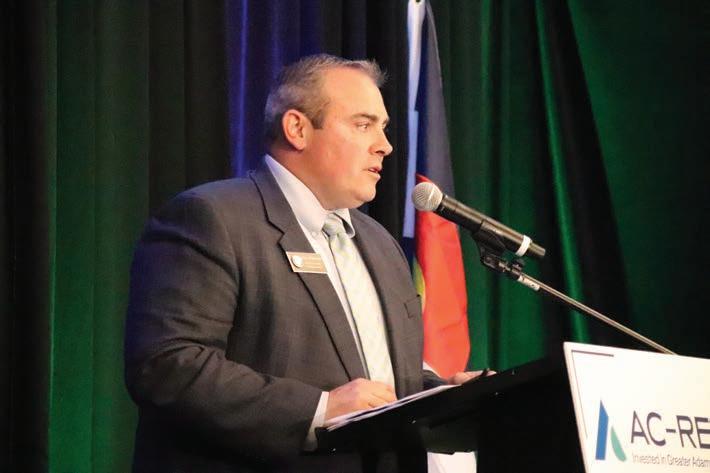
4 minute read
Staying viable as population growth slows
State of the Region talk focus on di erent kinds of growth rates in Adams County
BY SCOTT TAYLOR STAYLOR@COLORADOCOMMUNITYMEDIA.COM

With national population growth slowing, State Demographer Elizabeth Garner suggested Adams County business and government leaders prepare for what comes next.
“If we look at our growth over 2020 through 2022, what do we see? We see a super slow down in the Denver Metro area,” Garner said, speaking at the Adams County Regional Economic Partnership State of the Region luncheon May 11 at the Delta Hotel in Northglenn. “We see Denver, Je erson, Boulder losing population.”
And while Adams County is bucking that trend, with a reliably young population, current trends show the county’s population growth slowing.
“And if we are uncomfortable with that slowing, maybe we need to look at other factors and why we are so uncomfortable,” she said.
Garner was the keynote speaker at the AC-REP luncheon that featured Governor Jared Polis and Adams County Commission Chair Steve O’Dorisio. AC-REP, the partnership group, hosts a State of the Region event each year for local government o cials and employers in the northern Metro Denver region.
Garner was the nal speaker at the event, following both O’Dorisio and Polis. While they focused on accomplishments in the state and the county, Garner’s presentation framed those actions by talking about the state’s economic condition.
Economic growth follows population
Much of it starts with population, which starts with the birth rate. Birth rates are not growing as fast as they did in the past.
“ e big piece to take away from this is to know that over the last decade, the United States grew at its second slowest rate ever,” she said. “What? Yeah, the slowest since the Great Depression in the 1930s. So, Big Mama is slowing down.”

Meanwhile, Colorado’s population grew at twice the national rate, which helped keep the state economically viable while also pushing pressure for new housing.
But Colorado is slowing, too and she said that trend will continue. She noted that many of the states with the lowest birth rates are net population donors to Colorado. at means that eventually, fewer people will be moving to Colorado.
She projected continued growth of working-age residents in several counties, including Adams County.
“Now, I will tell you, Weld County represented 43% of the total growth in the under-18 population,” she said. “So, make nice with Weld County. I’ll be honest with you. Adams County is not far behind.” e region needs two things to keep attracting working-age residents — jobs and housing. She blamed the state’s current housing crunch on the boom-and-bust cycle of the state’s housing industry.

“ e Great Recession wrecked construction in building housing units,” she said. “We were building between 40,000 and 50,000 units per year and we went to 10,000. For 10 years, we built fewer housing units than households that were formed. Do you think that’s a problem? We have this boom and bust cycle with housing construction, so that is something to work on.”
In his speech, Polis said he’s trying to help reduce barriers to home construction and allow alternatives to single-family homes, including duplexes and buildings with multiple dwelling units. Better supply will keep housing prices more reasonable.
“I think if we can address it sooner rather than later, we can keep Adams County from becoming Boulder and Colorado from becoming California,” Polis said.
Adams County Commissioner O’Dorisio, the rst speaker at the luncheon, said the county is investing in home repair programs to help seniors stay in their homes longer and encouraging new housing development while investing in transitional housing for the unhoused. It’s one part of an overall e ort to use the county’s assets as wisely as possible.
“We are the hub of logistics because we are where the rivers, the highways and the businesses all come together,” O’Dorisio said.
Operations and Community Preservation Manager Aric Otzelberger said the new rules will resemble Westminster’s long-term rental rules. ere must be 150 square feet for the primary occupant and then 100 square feet for each occupant after that. As well, there must be a 70-square-foot bedroom for the primary occupant and 30 square feet for each occupant after that.
Nurmela asked if one person could own a short-term rental and then also own one through a di erent LLC. Otzelberger said that each entity would be considered a separate person, but there is no evidence he is aware of in surrounding communities with individuals owning multiple short-term rentals.
“Is it possible? Perhaps. But (this resolution is) intended as a starting place,” he said.
10
20%% e licenses also will have a threestrike policy regarding code compliance and complaints, but the city will have autonomy for enforcement mechanisms.
City Attorney David Frankel said if a renter stays more than 30 days, it’s a long-term rental.
Emmons also asked if a married couple could own multiple properties. Otzelberger said technically if one spouse is the sole owner of one property and the other spouse is the sole owner of a di erent property, then yes, the married couple would own two properties.
Frankel also said that all who have ownership of the property would need to sign the application. at would apply to owners of an LLC as well. All owenrs would need to sign the application and if someone was on multiple applications, it would come to the sta ’s attention.
Otzelberger said that if there was a problem and the city saw a cause for concern that a change would be made, but Nurmela asked how the city would know there is a problem.
Otzelberger said the city tracks data on a weekly basis regarding shortterm rentals. In 2022, they made up around .4% of Westminster’s housing stock. If the number came to a point of concern, the city would consider a cap.










